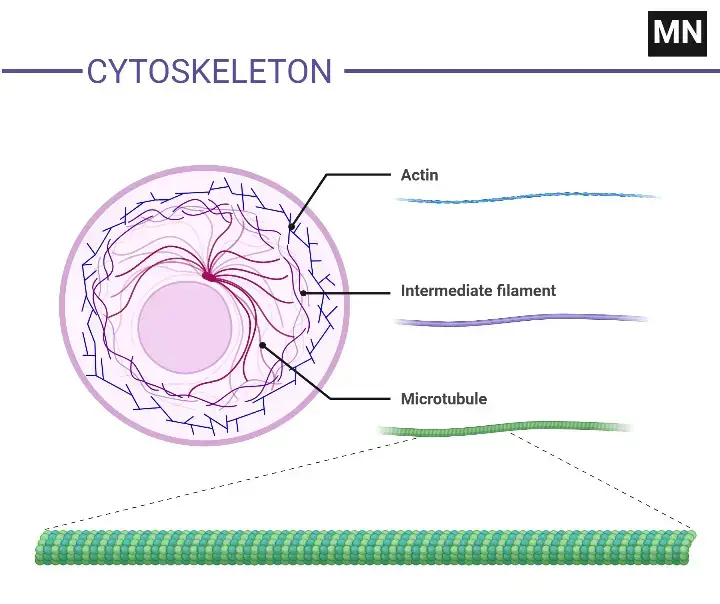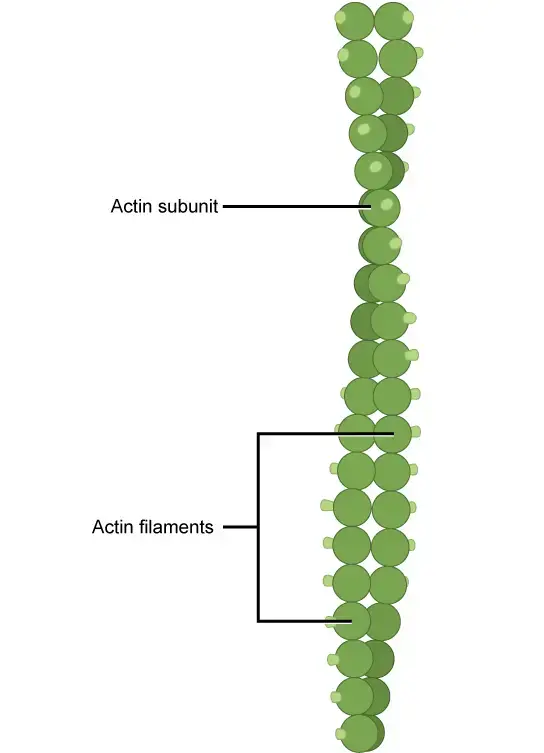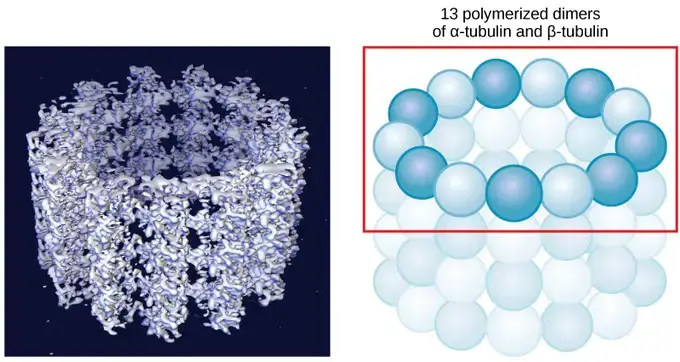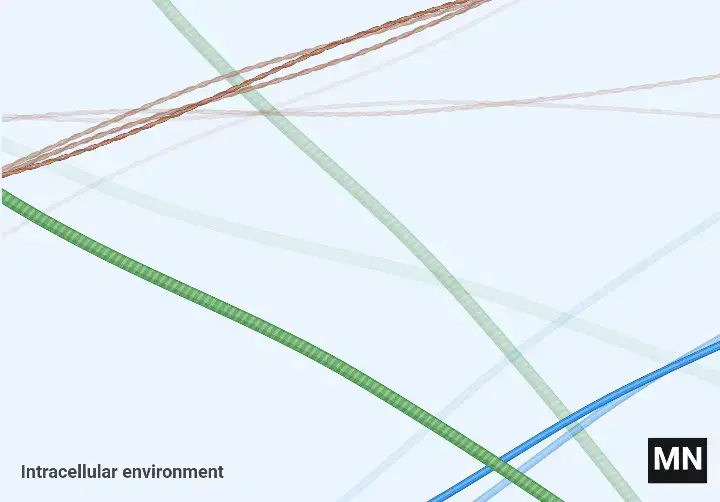The cytoskeleton is a dynamic network of protein filaments found in the cytoplasm of all cells, including those of bacteria and archaea. It stretches from the cell nucleus to the cell membrane in eukaryotes and is composed of the same proteins in all organisms. It consists of microfilaments, intermediate filaments, and microtubules, all of which are capable of fast growth or disassembly depending on the needs of the cell.
Cytoskeleton Definition (What is a cytoskeleton?)
- The cytoskeleton allows eukaryotic cells to change shape and perform coordinated, purposeful motions.
- Microtubules, microfilaments (or actinfilaments), and intermediate filaments make up the cytoskeleton, which is a network permeating the whole cytoplasm (IFs).
- The cytoskeleton supplies the machinery for cytoplasmic cyclosis and is directly engaged in a wide variety of cellular and organismal motions (such as cell motility, muscle contraction, and the various morphological changes that occur in a growing vertebrate embryo).
- In contrast to prokaryotes, bacteria don’t appear to have a cytoskeleton, which suggests it played a key role in the development of eukaryotic cells.
- The existence of an organised fibre array or cytoskeleton in the structure of the protoplasm was hypothesised in 1928 by Koltzoff.
- He conceived of a cytoskeleton that determines both the shape of the cell and the changes in its form.
- The primary proteins that are present in the cytoskeleton are tubulin (in the microtubules),actin, myosin, tropomyosin and other (in the microfilaments) and keratins, vimentin, desmin, lamin and others (in intermediate filaments) (in intermediate filaments).
- Subunits of intermediate filaments are fibrous proteins, while tubulin and actin are globular proteins.
- The isolation of these cytoskeletal proteins has made significant strides in recent years. The arrangement of microtubules and microfilaments may also be analysed using light and electron microscopy thanks to the development of specific antibodies against these proteins.
- Evidence for the existence of a highly structured, three-dimensional lattice in the ground cytoplasm has also been provided by high-voltage electron imaging of entire cells.

Cytoskeleton Structure
At least three distinct types of fibres comprise the cytoskeleton: microtubules, microfilaments, and intermediate filaments. The microtubules are the thickest and the microfilaments are the thinnest of these fibres.
Protein Fibers
- Microtubules: Microtubules are hollow rods that primarily support and form the cell and serve as “routes” for organelle movement. Typically, microtubules are present in all eukaryotic cells. They vary in length and have a diameter of approximately 25 nm (nanometers).
- Microfilaments: Involved in muscular contraction, microfilaments or actin filaments are thin, rigid rods. Microfilaments are particularly common in muscle cells. Comparable to microtubules, they are found in all eukaryotic cells. Microfilaments consist mostly of the contractile protein actin and have a diameter of up to 8 nm. They are also involved in organelle mobility.
- Intermediate filaments: Microfilaments and microtubules are supported by intermediate filaments, which can be plentiful in many cells. Intermediate filaments also give microfilaments and microtubules with structural support. These filaments are responsible for the formation of keratins in epithelial cells and neurofilaments in neurons. These are 10 nanometers in diameter.
1. Microfilaments
- Microfilaments, the thinnest component of the cytoskeleton, are employed to give the cell its form and sustain its interior organelles.
- If a cell’s organelles were removed, the plasma membrane and cytoplasm would not be the only remaining components. There would still be ions and organic molecules within the cytoplasm, as well as a network of protein fibres that assist preserve the structure of the cell, secure organelles in precise places, allow cytoplasm and vesicles to move throughout the cell, and allow unicellular organisms to move independently.
- This protein fibre network is known as the cytoskeleton.
- Within the cytoskeleton, there are three types of fibres: microfilaments, intermediate filaments, and microtubules.
- Microfilaments are the thinnest of the three types of protein fibres found in the cytoskeleton.
- They function in cellular motility, have a diameter of around 7 nm, and are composed of two entwined actin filaments. Microfilaments are sometimes called as actin filaments for this reason.

Functions of Microfilaments
- Microfilaments facilitate cell mobility and are composed of the protein actin.
- Myosin and actin collaborate to produce muscle contractions, cell division, and cytoplasmic streaming.
- Microfilaments maintain the position of organelles within the cell.
2. Microtubules
- Microtubules are a component of the cytoskeleton and assist the cell withstand compression, transport vesicles, and split chromosomes during mitosis.
- Microtubules are, as their name implies, little hollow tubes. Microtubules, along with microfilaments and intermediate filaments, are categorised as cytoskeleton organelles.
- The cytoskeleton is the framework that provides structural support for the cell.
- Microtubules comprise the majority of the cytoskeleton.
- The microtubule is composed of polymerized dimers of the globular proteins -tubulin and -tubulin.
- With a diameter of around 25 nm, microtubules are the largest cytoskeleton components.
- They assist the cell in resisting compression, offer a pathway for vesicle transport, and draw replicated chromosomes to opposing ends of a dividing cell. Microtubules, like microfilaments, can dissolve and rebuild rapidly.
- Microtubules are structural components of flagella, cilia, and centrioles, as well (the latter are the two perpendicular bodies of the centrosome ).
- The centrosome is the microtubule-organizing core in animal cells.
- In eukaryotic cells, flagella and cilia are structurally distinct from their prokaryotic counterparts.

Functions of Microtubules
- Microtubules aid the cell in resisting compression, offer a pathway for vesicles to travel within the cell, and are the building blocks of cilia and flagella.
- Cilia and flagella are hair-like structures that aid in cell motility and line various structures to capture particles.
- Cilia and flagella are composed of a “9+2 array,” which consists of a ring of nine microtubules encircled by two additional microtubules.
- During cell division, microtubules bind to replicated chromosomes and pull them to opposing poles, allowing the cell to split with a complete set of chromosomes in each daughter cell.
3. Intermediate Filaments
- Animal cells include intermediate filaments (IFs) as cytoskeletal components.
- They consist of a family of similar proteins that share structure and sequence characteristics.
- Intermediate filaments have an average diameter of 10 nanometers, which is between that of 7 nm actin (microfilaments) and that of 25 nm microtubules. However, they were originally labelled “intermediate” because their average diameter is between those of narrower microfilaments (actin) and wider myosin filaments found in muscle cells.
- Intermediate filaments contribute to cellular structural elements and frequently play a critical role in maintaining tissues such as skin together.
- Research indicate that there are more than 50 distinct types of intermediate filaments, which can be categorised into six primary groups:
- Type 1 and II – In the majority of epithelial cells, type 1 and type II consist of approximately 15 distinct proteins.
- Type III – This group of proteins contains vimentin and desmin, among others.
- Type IV – This category contains proteins present in nerve cells, such as -internexin and neurofilament proteins.
- Type V – Lamins are an example of a protein belonging to this group.
- Type VI – Found in neurons, just like nestin.
- Keratin is one of the most essential proteins involved in intermediate filament formation. This is the fibrous protein typically found in skin and hair.
- During assembly, the central rod domains of two polypeptide chains are initially wrapped around each other to form a coiled (dimer) shape. The resultant dimers then combine to form tetramers, which assemble at their ends to produce protofilaments (end to end). The protofilaments are ultimately organised into intermediate filaments.
- Intermediate filaments range in diameter from 8 to 10 nm, hence the term “intermediate filaments.” They are also more durable than the other two since they are more robust.
- Although proteins may not undergo dynamic instability like microtubules, they are frequently changed by phosphorylation from intermediate filaments. This plays an important function in their assembly within the cell.
- In numerous cell types, intermediate filaments extend from the nucleus surface to the cell membrane. By the intricate network they generate in the cytoplasm, these filaments also connect with the other components of the cytoskeleton, which contributes to their roles.
Functions of Intermediate Filaments
- Intermediate filaments contribute to cellular structural elements and frequently play a critical role in maintaining tissues such as skin together.
3. Motor Proteins
Many motor proteins are present in the cytoskeleton. These proteins, as their name suggests, actively move cytoskeleton fibres. Hence, chemicals and organelles are distributed throughout the cell. ATP, which is created by cellular respiration, provides energy to motor proteins. There are three different types of motor proteins that are involved in cell movement.
- Kinesins: Kinesins migrate along microtubules while transporting cellular components. Typically, they are utilised to draw organelles towards the cell membrane.
- Dyneins: Similar to kinesins, dyneins are utilised to draw cellular components towards the nucleus. As observed in the movement of cilia and flagella, dyneins also function to slide microtubules relative to each other.
- Myosins: Myosins and actin interact to produce muscle contractions. In addition, they participate in cytokinesis, endocytosis, and exocytosis (exo-cyt-osis).
| Cytoskeleton type | Diameter (nm) | Structure | Subunit examples |
|---|---|---|---|
| Microfilaments | 6 | Double helix | Actin |
| Intermediate filaments | 10 | Two anti-parallel helices/dimers, forming tetramers | Vimentin (mesenchyme)Glial fibrillary acidic protein (glial cells)Neurofilament proteins (neuronal processes)Keratins (epithelial cells)Nuclear lamins |
| Microtubules | 23 | Protofilaments, in turn consisting of tubulin subunits in complex with stathmin | α- and β-Tubulin |
Flagella and Cilia
- Flagella (singular = flagellum) are long, hair-like structures that extend from the plasma membrane and are responsible for propelling the entire cell (for example, sperm, Euglena).
- When flagella are present, the cell has only one or a few flagella. However, when cilia (singular = cilium) are present, many of them stretch along the entire plasma membrane surface.
- They are short, hair-like structures utilised to transport complete cells (such as paramecia) or chemicals along the cell’s outer surface (for example, the cilia of cells lining the Fallopian tubes that move the ovum toward the uterus, or cilia lining the cells of the respiratory tract that trap particulate matter and move it toward your nostrils).
- Despite their length and number disparities, flagella and cilia have a common microtubule arrangement known as a “9 + 2 array.”
- A single flagellum or cilium consists of a ring of nine microtubule doublets around a single microtubule doublet at its core.
Many different types of motor proteins compose the cytoskeleton. Among these are:
- Kinesin: Microtubules are responsible for transporting the various cellular components, and these proteins travel along them. They exert a pulling force on the organelles, dragging them parallel to the cell membrane.
- Dyneins: The organelles in the cell are drawn closer to the nucleus by these.
- Myosin: These trigger muscular contractions by interacting with actin protein. Cytokinesis, exocytosis, and endocytosis are also carried out by these cells.
Cytoskeleton Function (what is the function of the cytoskeleton?)
- Cell shape and mechanical support: The cytoskeleton provides the cell with a defined shape and helps it maintain its structural integrity. It also allows the cell to resist external forces. The cytoskeleton maintains the positions of numerous cellular organelles.
- Cell movement: The cytoskeleton is responsible for cell movement, including the movement of cilia and flagella. It also allows cells to change their shape during processes such as cell division and migration.
- Intracellular transport: The cytoskeleton plays a critical role in the transport of materials within the cell. Microtubules serve as tracks for the movement of organelles and other cellular components, while microfilaments and intermediate filaments anchor these structures in place.
- Cell division: The cytoskeleton is essential for cell division, helping to organize and separate the chromosomes during mitosis.
- Signal transduction: The cytoskeleton plays a role in signal transduction pathways, which are essential for cell communication and coordination. The cytoskeleton facilitates the transfer of intercellular communication impulses.
- Vacuoles Formation: It aids in the development of vacuoles.
- Cilian and Flagella: In some cells, it generates appendage-like protrusions, such as cilia and flagella.
What is a Microtrabecular Lattice?
- In recent years, it has been clear that the cytoplasm contains a micro-trabecular lattice, a three-dimensional network of interconnected filaments of cytoskeletal fibres.
- It is this lattice that many cellular organelles, including ribosomes, lysosomes, and others, attach to for support.
- Since the micro-trabecular lattice is malleable, the form of the cell also alters as the cell migrates.

Cytoplasmic Streaming
- The cytoskeleton contributes to cytoplasmic streaming. This process, also known as cyclosis, includes the movement of cytoplasm within a cell to circulate nutrients, organelles, and other things. Cyclosis also facilitates endocytosis and exocytosis, or the movement of material into and out of a cell.
- As microfilaments of the cytoskeleton contract, they help control the movement of cytoplasmic particles. When microfilaments connected to organelles contract, the organelles are dragged along and the cytoplasm follows suit.
- Both prokaryotic and eukaryotic cells have cytoplasmic streaming. In protists, such as amoebae, this mechanism generates cytoplasmic extensions known as pseudopodia. These structures are utilised for food capture and movement.
Prokaryotic cytoskeleton
- Prior to the work of Jones et al., 2001, it was believed that the cell wall determined the shape of many bacterial cells, including rods and spirals. Several malformed bacteria were found to contain mutations associated with the formation of a cell envelope.
- The cytoskeleton was formerly believed to be exclusive to eukaryotic cells, but homologues of all the key eukaryotic cytoskeleton proteins have been identified in prokaryotes. Until to 1992, only eukaryotes were believed to have cytoskeleton components, according to Harold Erickson.
- However, research conducted in the early 1990s revealed that bacteria and archaea have actin and tubulin homologues, and that they were the building blocks of eukaryotic microtubules and microfilaments.
- Although the evolutionary relationships between the eukaryotic and prokaryotic cytoskeletons are so distant that they are not evident from protein sequence comparisons alone, the similarity of their three-dimensional structures and similar functions in maintaining cell shape and polarity provide strong evidence that they are indeed homologous.
- Three laboratories independently determined that FtsZ, a protein previously identified as a major role in bacterial cytokinesis, possessed the “tubulin signature sequence” found in all -, -, and -tubulins. Yet, certain bacterial cytoskeleton structures may not have been found as of yet.
FtsZ
- FtsZ was the first bacterial cytoskeleton protein to be identified. FtsZ generates filaments in the presence of guanosine triphosphate (GTP), similar to tubulin, but these filaments do not form tubules.
- FtsZ is the first protein to migrate to the division site during cell division and is necessary for recruiting other proteins that construct the new cell wall between dividing cells.
MreB and ParM
- MreB and other prokaryotic actin-like proteins are important in the preservation of cell shape. All non-spherical bacteria contain genes for actin-like proteins, which form a helical network beneath the cell membrane that directs the proteins involved in cell wall construction.
- Certain plasmids encode an independent mechanism involving the actin-like protein ParM. Filaments of ParM are dynamically unstable and may partition plasmid DNA into daughter cells by a mechanism similar to that utilised by microtubules during eukaryotic mitosis.
Crescentin
- Crescentin, a third protein found in Caulobacter crescentus, is connected to the intermediate filaments of eukaryotic cells.
- The method through which crescentin plays a role in preserving cell shape, including helical and vibrioid forms of bacteria, is still unknown.
- In addition, the displacement of crescentic filaments following the disruption of peptidoglycan synthesis could be used to characterise curvature.
Comparison Of Microtubules, Intermediate Filaments And Microfilament
| Property | Microtubules | Intermediate filaments | Microfilaments |
| Structure | Hollow with walls made up of 13 protofilaments | Hollow with walls made up of 4 to 5 protofilaments | Solid made up of polymerized actin (F-actin) |
| Diameter (nm) | 24-25 | 10 | 7-9 |
| Monomer units | α- and β- tubulin | Five types of protein defining five major classes | G-actin |
| ATPase activity | Present in dynein arms | None | None |
| Functions | 1. Motility of eukaryotes 2. Chromosome movement 3. Movements of intracellular materials 4. Contribute toward maintaining cell shape | 1. Integrate contractile units in muscle 2. Cytoskeletal structural function in cytoplasm | 1. Muscle contraction 2. Cell shape changes 3. Protoplasmic streaming 4. Cytokinesis |
FAQ
What is the function of the cytoskeleton? or what does the cytoskeleton do?
Some of the major cytoskeleton duties are as follows:
It helps give the cell its form and structure.
Vacuole formation is aided by this factor.
Many parts of the cell are held in place by it.
It functions as a cell signalling aid.
It aids cellular processes like organelle transport, vesicle trafficking, and other intracellular processes.
Which of the following functions is NOT associated with the cytoskeleton in eukaryotic cells?A. Intracellular transportB. Maintenance of cell shape and structureC. Support of the organellesD. Cell motilityE. None of these
the correct option is E) None of the above.
What is a cytoskeleton?
Cells of all three kingdoms—eukaryotes, prokaryotes, and archaea—are built upon a framework called the cytoskeleton. These fibres in eukaryotic cells are made up of a tangled web of protein filaments and motor proteins that facilitate cell motility. It helps keep the cell together, keeps the organelles in their proper places, and allows for the movement of molecules, cell division, and the transmission of signals.
Where is the cytoskeleton located?
Cytoskeleton, a system of filaments or fibres that is present in the cytoplasm of eukaryotic cells (cells containing a nucleus).
What is the cytoskeleton made of?
The cytoskeleton of a cell is made up of microtubules, actin filaments, and intermediate filaments.
References
- Stephen R. Bolsover, Elizabeth A. Shephard, Hugh A. White, Jeremy S. Hyams (2011). Cell Biology: A short Course (3 ed.).Hoboken,NJ: John Wiley and Sons.
- Cytoskeleton. (2008). Medical Cell Biology, 59–100. doi:10.1016/b978-0-12-370458-0.50008-6
- Ghosh, S., Kaplan, K. J., Schrum, L. W., & Bonkovsky, H. L. (2013). Cytoskeletal Proteins. International Review of Cell and Molecular Biology, 279–319. doi:10.1016/b978-0-12-407699-0.00005-4
- Alberts, B. (2004). Essential cell biology. New York, NY: Garland Science Pub.
- https://biologydictionary.net/cytoskeleton/
- https://www.biologyonline.com/dictionary/cytoskeleton
- https://www.numerade.com/books/chapter/cytoskeleton/?utm_campaign=dynamic_books_international&utm_term=dynamic_books_international&utm_content=dynamic_books_international_&utm_source=google&utm_medium=paidsearch&gclid=CjwKCAjwq-WgBhBMEiwAzKSH6FQ4JCBC5uJCVuB01yAOhl-Bj8Sldg2l466DRGGcUsmJzdw0V6ZyuBoCBJwQAvD_BwE
- https://www.thoughtco.com/cytoskeleton-anatomy-373358
- https://www.coursehero.com/study-guides/boundless-biology/the-cytoskeleton/